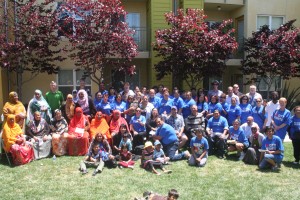But blame for bus deficiencies didn’t rest squarely on the Metropolitan Transit System, which maintains the buses and sets fares. Instead, attendees criticized planning authorities and elected officials who say there just isn’t enough money to better fund MTS and back new transit projects.
 The forum attracted many from City Heights’ refugee and immgrant communities. | Photo Credit: Randy Van Vleck |
“Don’t be fooled when people say there’s no money for vital services,” Councilwoman Marti Emerald told the crowd of more than 100. “What there is is a lack of vision and setting priorities.”
Many community advocates said that lack of vision is most evident in the San Diego Association of Governments boardroom. The planning group allocates funding to MTS and sets how and when the region spends on transportation. Last year, transit supporters lambasted its current plan for prioritizing freeway expansions before major bus and trolley improvements.
That’s why forum organizers called on Emerald and her opponent in the race for District 9, Mateo Camarillo, to replace outgoing City Heights Councilman Todd Gloria on SANDAG’s transportation committee if elected. Both agreed, though Emerald said she would have to leave SANDAG’s public safety committee to do so.
Mayoral candidate and Congressman Bob Filner also made a promise to attendees.
“We are going to provide free public transportation for our children when I am mayor of San Diego,” Filner said. “The money is there.”
Filner told Speak City Heights he would fund free student bus passes by claiming downtown redevelopment dollars, funds from a recently approved hotel tax (meant to fund a new convention center) and savings from his pension plan for projects in disadvantaged neighborhoods.
Gloria, who also spoke in favor of transit improvements, wasn’t as bold as his campaigning counterparts.
“The money [for student bus passes] has to come from somewhere else,” Gloria said. “That could mean that you raise fares for someone else.”
Jay Powell, the former executive director of the City Heights Community Development Corporation, said Gloria’s comment exemplified the lack of vision transit advocates were referring to.
“‘Cut that to pay for that,’” he said, paraphrasing Gloria. “We can’t buy that.”
Currently, SANDAG allocates 16 percent of its funds from TransNet, a regional half-cent sales tax, to subsidize bus and trolley services for senior, disabled and youth riders. The board could adjust the allocation with a two-thirds vote.
It could also amend most of its TransNet capital improvement plans with a two-thirds vote. SANDAG plans to spend nearly twice as much on highway infrastructure as it will on new transit infrastructure and services. Most of the highway projects, however, include special lanes for rapid bus transit.
Attendees lifted some of the pressure on SANDAG with another option: finding a company or foundation to sponsor free bus passes for City Heights students.
No matter the source of the funding, Rob Schupp, director of marketing and communications for MTS, said his colleagues would be happy to put it to use.
“What’s really great about this group is it’s the only community that fights for public transit,” Schupp said. “Their goals are our goals.”
